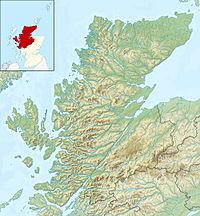The Aird facts for kids
The Aird (from Scottish Gaelic: An Àird, meaning "The High Place") is a special area in Scotland. It is located west of the city of Inverness.
This region sits south of the River Beauly and the Beauly Firth. It is also north of Glenurquhart and the northern end of Loch Ness.
Villages found within The Aird include Kirkhill, Kiltarlity, Lentran, and Inchmore.
The Aird is known as the traditional home of the Clan Fraser of Lovat. Their family's main home, Beaufort Castle, is located here. The first known leader of The Aird was Iain Mac Eoin Nan Gleann, also called "John Bisset of the Glens."
Today, this area gives its name to a local government district. This district is called Aird and Loch Ness and is part of the Highland Council.
Exploring the History of The Aird
Ancient Battles and Early Records
One interesting historical site in The Aird is Blar Nam Feinne (grid reference NH595433). This spot on Cnoc na Moine is said to be where a battle happened long ago. It was fought in the early 11th century between King Malcolm and Thorfinn of Norway.
The Aird was first written about as a provincial lordship between the years 1203 and 1221. A lordship was like a territory ruled by a lord. However, it only stayed as one single territory until 1259. After that, it was divided among three daughters of John Bissett of Lovat and their husbands.
Understanding the Size of The Aird
It is not completely clear how big the lordship of The Aird was. We know for sure it included the parishes of Convinth, Farnua, Kiltarlity, and Dunballoch. These areas were all part of the Province of Moray.
The Aird might also have included the parish of Glenelg. This area is on the west coast of Scotland. It is special because it might have included land outside its main province. This land included Edirdovar, which is now Redcastle on the Black Isle. It also included land within the parish of Kilmorack. Both of these places were in the Province of Ross.
The Aird is also believed to be the place where Donald Balloch was defeated. This event happened in the 15th century.


